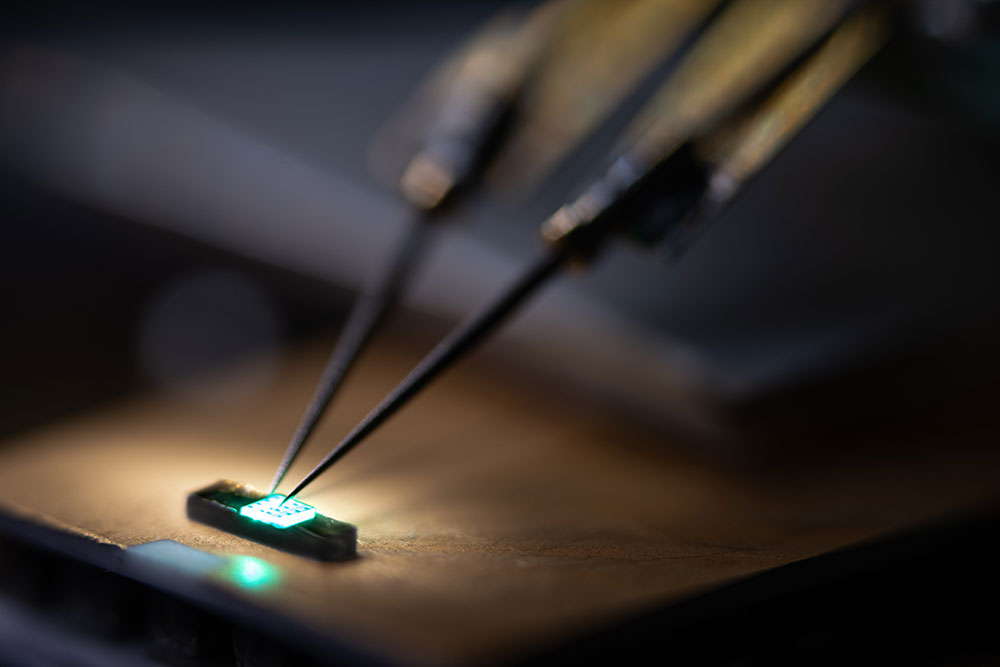
Yuan-Yu Jau is on a quest to build the world’s smallest atomic clock, a device that measures time with extreme accuracy. If successful, he and his team at Sandia will have made one smaller than a sugar cube.
But he’s not the only one pushing the limits of tiny timepieces.
Last year, the Defense Advanced Research Projects Agency challenged research teams to build smaller, more accurate clocks. Yuan-Yu is leading the Sandia team engaged in this effort.
“They want 1 cubic centimeter for everything, and currently there’s no atomic clock with this kind of size,” said Yuan-Yu, whose core design is even smaller — about 1 centimeter long and a mere 2 millimeters wide and tall, for a grand total of 0.04 cubic centimeters. DARPA requested the devices to be accurate within one-millionth of a second after one week.
Sandia has experience building compact clocks. In the early 2000s, the Labs helped develop the Chip Scale Atomic Clock, which is little larger than a matchbook, or about 17 cubic centimeters. At the time, CSAC was the smallest atomic clock in the world, and is still the smallest one you can buy.
Miniature clocks enable advanced navigation technology
The atomic clock was invented in 1948 at what was then the U.S. National Bureau of Standards, now the National Institute of Standards and Technology. Rather than measuring time by astronomical events like the Earth’s rotation, or by mechanical means like gears, springs or pendulums, it measured time by electromagnetic signals emitted by electrons around an atom, making it incredibly precise.
Atomic clocks paved the way for GPS, which relies on super-accurate, synchronized clocks.

Ironically, DARPA is now investigating small, accurate clocks to help vehicles navigate when GPS is unavailable. This works like how you might calculate distance driving a car on a long stretch of highway. If you drive a steady 60 miles per hour, you know after one hour you’ve traveled 60 miles. A trusty clock is half the equation.
For defense applications, navigation must be extremely precise. DARPA is seeking clocks that are accurate to millionths of a second for up to a week. While the world’s best clocks are large machines that can maintain this accuracy for tens of thousands of years, pocket-sized versions are less accurate. Sandia’s and DARPA’s goals are to be 30 times more accurate than current state-of-the-art, small-scale clocks.
The agency also requires improvements in power consumption and sensitivity to temperature and vibration.
“This is way more challenging than what people have done so far,” Yuan-Yu said.
Reducing size, weight and power makes advanced navigation systems easier to field in different kinds of vehicles — from naval vessels to drones and satellites.
Clock design based on 16-year-old prototype
Yuan-Yu is confident he and his team can build the device. In a way, he already has.
Sixteen years ago, then a physics instructor at Princeton University, he built his first prototype of what he called a laser atomic oscillator. It was about the size of a toolbox, but it performed the same basic action as an atomic clock. It produced a steady, clocklike pulse derived from shining a laser through a cloud of potassium atoms.

Importantly, it was self-contained. The oscillator did not require outside electronic equipment to control the machine’s periodic pulse.
Support hardware is common in many kinds of atomic clocks, and it usually takes up most of the space. If you removed the support electronics from a matchbook-sized CSAC, you’d find the physical ticking takes place in a package only about the size of a grain of rice.
Yuan-Yu said his prototype was only as large as it was because a big machine was easier to build than a small one, “You know, with my sausage fingers.”
Now, he has the tools to make it smaller.
Team to build device at Sandia microelectronics facility
Yuan-Yu plans to swap out potassium atoms for cesium and shrink his original design using machines and tools at Sandia’s Microsystems Engineering, Science and Applications complex, a hybrid research, development and production facility for microelectronics.
Because his design doesn’t need peripheral hardware, he thinks he can dramatically reduce the size, weight and power requirements of atomic clocks.
“We will use only the volume of the physics package that exists in the existing CSAC clock, but we will get rid of those complicated electronics around it,” Yuan-Yu said.
His initial funding under DARPA is for two years, with the possibility of additional funding if he and his team meet size and performance benchmarks.